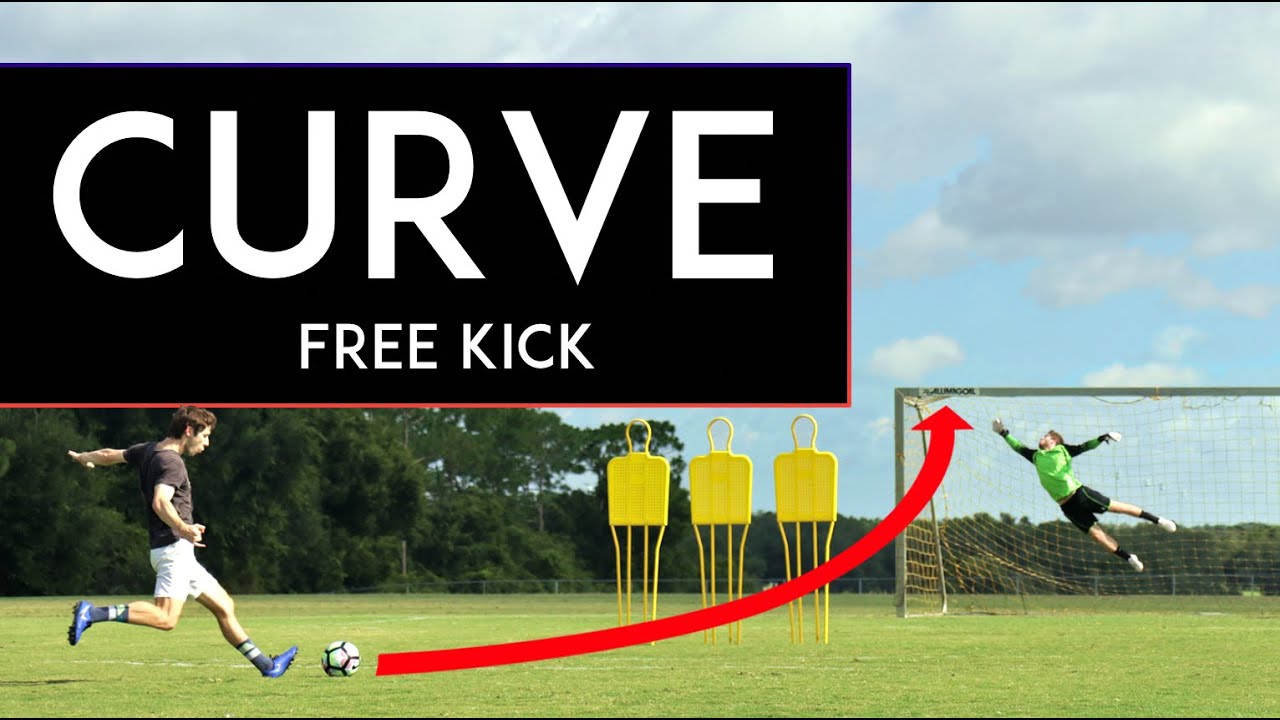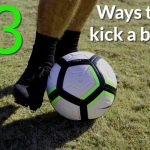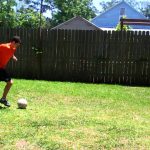To curve a soccer ball, kick the ball with the inside or outside of your foot at an angle. Curving the ball requires proper technique and practice.
Soccer is a game that demands a diverse range of skills from its players, including shooting accuracy. The ability to curve a soccer ball can be a useful technique to add to your arsenal. By mastering the art of curving the ball, you can deceive opponents, create scoring opportunities, and control the flow of the game.
To curve the ball, you need to impart a spin on it, causing it to swerve in the air. This can be achieved by striking the ball with the inside or outside of your foot at the correct angle. In this guide, we will explore the techniques and tips to help you curve a soccer ball effectively.
Understanding The Mechanics Of Curving A Soccer Ball
Understanding the mechanics of curving a soccer ball is essential for players looking to add finesse and precision to their game. Mastering this skill allows players to manipulate the trajectory of the ball, creating unexpected curves and making it challenging for goalkeepers to predict its path. In this section, we will delve into the important aspects that contribute to the curving of a soccer ball.
Importance Of Foot Contact And Body Position
Achieving an accurate curve on a soccer ball requires proper foot contact and body position. The way your foot connects with the ball is crucial for determining the spin and direction of the curve. To effectively curve the ball, you need to make contact with the ball using the inside or outside of your foot, depending on which curve you want. When curving the ball to the left, use the inside of your foot, and when curving it to the right, use the outside of your foot.
Additionally, your body position plays a significant role in curving the ball successfully. As you approach the ball, plant your non-kicking foot slightly to the side of the ball and align your body with the target. By positioning your body correctly, you can generate power and control on your shot, enhancing your chances of achieving the desired curve.
Utilizing The Correct Part Of The Foot For Desired Curve
To achieve the desired curve, it’s important to understand which part of the foot to use. When curving the ball to the left, using the inside of your foot is crucial. This allows you to create an inward spin on the ball, causing it to curve inwards. On the other hand, when curving the ball to the right, utilizing the outside of your foot enables you to create an outward spin, resulting in a curve away from your body.
It’s worth noting that the part of the foot you use to make contact with the ball will also affect the power and accuracy of your shot. The area just below your laces provides a good balance between power and control, allowing for a clean strike on the ball.
Factors Affecting The Ball’s Trajectory
Several factors can affect the trajectory of a curved soccer ball:
- Kick Angle: The angle at which you strike the ball determines the curvature. A more direct angle will result in a straight shot, while a more oblique angle causes the ball to curve.
- Spin: The amount of spin you apply to the ball also affects its trajectory. Adding more spin will increase the curve, while less spin will result in a milder curve.
- Speed: The velocity at which the ball is struck influences the curve. A faster shot tends to have less pronounced curvature, while a slower shot allows for more significant curvature.
- Air Resistance: The resistance the ball encounters in the air can alter its path. Wind conditions and the ball’s surface area can impact the amount of curve achieved.
By understanding these factors and practicing the correct techniques, players can develop the ability to curve the ball with precise control and add a valuable weapon to their arsenal.
Mastering The Inside Curve Technique
This short description provides expert guidance on mastering the inside curve technique in soccer. Learn how to effectively curve the ball with precision and control to take your game to the next level.
Step-by-step Guide To Performing The Inside Curve Technique
Mastering the inside curve technique in soccer can take your game to the next level. This technique allows you to manipulate the ball’s flight path, deceiving opponents and creating scoring opportunities. To help you learn and perfect this skill, follow these step-by-step instructions:
- Plant your non-kicking foot next to the ball, positioning it slightly behind the ball.
- Position your kicking foot on the side of the ball, ensuring your toes are pointing slightly inward.
- Focus on striking the ball with the inside of your foot, making contact towards the middle of the ball.
- As you strike the ball, apply a slight curling motion by using your ankle to roll the ball off the inside of your foot.
- Follow through with your kicking leg, allowing it to continue in the direction of your intended target.
Practicing these steps repeatedly will help you develop muscle memory and improve your ability to perform the inside curve technique accurately and consistently.
Tips For Improving Accuracy And Power
While mastering the inside curve technique requires practice, there are a few tips you can keep in mind to improve the accuracy and power of your curved shots:
- Maintain proper body alignment and balance throughout the technique, keeping your head steady and eye on the ball.
- Focus on striking the ball with the correct amount of power, neither too strong nor too weak. Gradually increase your power as you become more comfortable with the technique.
- Experiment with different angles and positions of your non-kicking foot to find the most comfortable and effective stance for executing the inside curve.
- Visualize the desired curve path before striking the ball, allowing your mind to guide your body’s movements.
By incorporating these tips into your training routine, you can refine your technique and enhance the accuracy and power of your inside curve shots.
Common Mistakes To Avoid While Attempting The Inside Curve
While learning any new skill, it’s important to be aware of common mistakes that can hinder your progress. Here are some mistakes to avoid when attempting the inside curve technique:
- Avoid striking the ball with the toe or the outside of your foot, as this can affect the desired curve and result in an inaccurate shot.
- Do not lean back or overextend your kicking leg, as this can lead to a loss of balance and decrease the accuracy of your shot.
- Avoid rushing your technique. Take your time to position yourself correctly and ensure proper execution of each step.
- Do not neglect practicing with both feet. Developing proficiency with your weaker foot will make you a more versatile and unpredictable player.
By steering clear of these common mistakes, you can overcome obstacles in your learning process and progress towards becoming a skilled inside curve practitioner.
Achieving The Outside Curve Effectively
The outside curve technique is a valuable skill for any soccer player looking to add variation and unpredictability to their shots and passes. With the ability to bend the ball away from defenders or into tight spaces, mastering the outside curve can truly elevate your game. In this section, we will break down the technique, discuss proper body positioning, and provide practice drills to enhance your accuracy.
Breakdown Of The Outside Curve Technique
To successfully execute the outside curve, a player must strike the ball with precision and apply the right amount of spin. Here’s a breakdown of the technique:
- First, plant your non-kicking foot next to the ball, slightly to the side. This will create a stable base and help you generate power.
- Before striking the ball, aim for the outside part of it with your kicking foot. Contacting the ball at the right spot is crucial for achieving the desired curve.
- As you swing your kicking foot towards the ball, focus on striking it with the instep or the region just below the laces. This will allow you to generate the necessary spin.
- Follow through with your kicking motion, ensuring your foot continues its path towards the target area.
Proper Body Positioning For Executing The Outside Curve
Body positioning plays a crucial role in executing the outside curve effectively. Here are some tips to help you maintain proper form:
- Position your body slightly sideways to the target, with your shoulder pointing in the direction you want the ball to curve.
- Keep your eyes focused on the ball throughout the entire process, allowing you to make accurate contact.
- Maintain a smooth and controlled swing, using your arms for balance and stability.
By following these tips, you’ll create the ideal setup to generate power, accuracy, and spin for your outside curve shots and passes.
Practicing Drills To Enhance Outside Curve Accuracy
To master the outside curve, practice is key. Here are a few drills to improve your accuracy:
| Drill | Description |
|---|---|
| Cones Target Practice | Set up a row of cones as targets and attempt to curve the ball around them. Start close and gradually increase the distance to challenge yourself. |
| Wall Passing Drill | Find a wall and practice passing against it with the outside curve technique. This drill helps you develop control and accuracy. |
| One-On-One Curve Challenge | Engage in one-on-one drills with a teammate or friend. Take turns executing outside curve shots and passes while creating challenges and obstacles. |
By regularly incorporating these drills into your training routine, you’ll enhance your outside curve accuracy and become a more formidable player on the field.
Now that you’ve learned the breakdown of the outside curve technique, proper body positioning, and effective practice drills, it’s time to hit the field and apply these skills. By consistently honing your outside curve, you’ll add a new level of versatility to your game and leave defenders guessing with every shot or pass.

Credit: www.wikihow.com
Advanced Techniques For Curving The Soccer Ball
Curving the soccer ball is a skill that can greatly enhance your gameplay abilities. It adds an element of unpredictability and can create scoring opportunities for you and your team. In this blog post, we will explore advanced techniques for curving the soccer ball, including the knuckleball technique, developing the banana curve skill, and tips for combining different curve techniques. By mastering these techniques, you’ll be able to take your soccer game to the next level.
Introducing The Knuckleball Technique
The knuckleball technique is a unique skill that allows you to curve the soccer ball in a way that confuses goalkeepers and defenders. It involves hitting the ball with minimal spin, causing it to move erratically through the air. To execute this technique, follow these steps:
- Place the ball on the ground and approach it with your non-dominant foot.
- Plant your non-dominant foot beside the ball, slightly to the side.
- Swing your dominant foot straight through the center of the ball, making sure to strike it with the laces.
- Try to avoid applying spin or bending of the foot upon impact to minimize the ball’s rotation.
- Follow through with your shot, maintaining a balanced stance.
Developing The Banana Curve Skill
The banana curve skill is a technique that allows you to create a curved trajectory for the soccer ball. By utilizing the inside or outside of your foot, you can bend the ball around defenders and goalkeepers. Here’s how you can develop this skill:
|

|
Tips For Combining Different Curve Techniques
To take your curved shots to an advanced level, you can combine different curve techniques to create unpredictable trajectories. Here are some tips to help you master this advanced skill:
- Practice each technique individually to become proficient in executing them with precision.
- Experiment with different combinations of the knuckleball technique and the banana curve skill to discover unique shot variations.
- Adjust the power and angle of your shots to influence the curve.
- Focus on your body positioning and strike accuracy to achieve consistent results.
- Study professional players and analyze how they effectively combine curve techniques in their gameplay.
By mastering these advanced techniques and consistently practicing, you’ll be able to curve the soccer ball with precision and confidence. Incorporate these techniques into your training routine and surprise your opponents with your newfound ability to bend the ball in all directions.
Enhancing Curve With Training And Equipment
Curving a soccer ball is a skill that can take your game to the next level. With the right training and equipment, you can become a master at bending shots around defenders and into the back of the net. In this article, we will explore how to enhance your curve execution through targeted leg muscle strengthening, the use of training aids, and selecting the appropriate soccer ball for curving practice. Let’s dive in!
Strengthening The Leg Muscles For Better Curve Execution
Having strong and agile leg muscles is essential for executing a perfect curve on the ball. Here are some exercises and techniques to help you strengthen your leg muscles:
- Resistance band squats: Place a resistance band around your thighs, above your knees. Perform squats while maintaining tension on the band. This exercise targets your quads, hamstrings, and glutes, improving your kicking power and accuracy.
- Sprint intervals: Sprinting helps build explosive leg power, which translates into stronger shots. Incorporate short sprint intervals into your training routine to enhance your leg muscles’ strength and speed.
- Single-leg lunges: Stand with one leg forward and the other leg extended back. Lower your body into a lunge position, keeping your knee above your ankle. This exercise improves balance and stability while strengthening your quadriceps and glutes.
Utilizing Training Aids To Improve Curve Proficiency
To further enhance your curve technique, consider utilizing the following training aids:
- Curved practice walls: These specialized training walls have a curved surface that mimics the trajectory of a curving shot. Practicing against a curved wall can help you get a feel for the ball’s movement and improve your curve accuracy.
- Cone and obstacle drills: Set up cones or obstacles in a curved pattern and practice dribbling through them while executing curved shots. This drill helps improve your curve technique and decision-making abilities during gameplay.
- Balance boards: Using a balance board while practicing curve shots helps develop core stability and improves your body’s control and balance, further enhancing your curve executions.
Selecting The Appropriate Soccer Ball For Curving Practice
Choosing the right soccer ball for curving practice is crucial. A ball that provides consistent flight and grip will allow you to better control and manipulate the curve. Consider the following factors when selecting a soccer ball:
- Quality and construction: Opt for a high-quality ball with a durable outer cover, as it will offer better control and responsiveness when curving.
- Size and weight: Ensure that the ball you choose is the appropriate size and weight for your age and skill level. This ensures a comfortable grip and optimal control during curve practice.
- Surface type: Consider the surface on which you will primarily be playing. Different balls are designed for use on specific surfaces, such as grass, turf, or indoor courts. Choose a ball specifically suited for the surface you’ll be practicing on.
By incorporating targeted leg muscle strengthening exercises, utilizing training aids, and selecting the appropriate soccer ball, you can enhance your curve execution skills and take your game to new heights. Practice regularly and stay committed, and soon you’ll be bending shots like a pro!
Frequently Asked Questions On How To Curve A Soccer Ball
How Do You Curve A Soccer Ball?
To curve a soccer ball, you need to strike the ball with the inside or outside of your foot, depending on the desired direction. Apply spin by striking the ball at the correct angle and using the right amount of power.
Practice and mastering techniques like the swerve and knuckleball will help you achieve impressive curve shots.
What Is The Physics Behind Curving A Soccer Ball?
Curving a soccer ball involves the Magnus effect. When the ball spins, it creates a difference in airflow above and below the ball. This causes a pressure difference, resulting in a curved trajectory. The side spin determines the direction of the curve, while the speed and spin rate influence the degree of the curve.
How Do Professional Soccer Players Curve The Ball So Effectively?
Professional soccer players achieve effective curve shots through consistent practice, mastering the techniques, and developing a deep understanding of the physics involved. They focus on striking the ball accurately with the right part of their foot, applying the appropriate power, and controlling the spin to achieve the desired curve.
Does The Type Of Soccer Ball Affect Its Curving Potential?
The type of soccer ball does influence its curving potential. Balls with a rougher surface provide more friction, allowing for better grip on the air. Additionally, balls made of high-quality materials and designed for professional play tend to offer better control and enhanced curving capabilities compared to lower-quality or recreational balls.
Conclusion
Mastering the art of curving a soccer ball can elevate your game to new heights. By understanding the techniques and practicing diligently, you can acquire the skills needed to bend the ball with precision and accuracy. Remember to focus on your body positioning, strike the ball correctly, and practice regularly to develop muscle memory.
With consistent effort and perseverance, you can become a proficient curver of the soccer ball, adding an impressive weapon to your arsenal on the field. Take your time to learn, practice, and enjoy the journey of perfecting this technique. Keep refining your skills and watch as your ability to curve the soccer ball expands your impact on the game.

General Manager & Auditorial Head.
Killian Jake is a World Sports Traveler and hobbyist sports lover. By exploring different sorts of playing modules like indoor, outdoor, and many more. As for professionalism and writing, it’s helpful to give you the right suggestions on different games and sports.





